The federal government collects revenues and makes expenditures in all provinces. Per capita federal revenues and spending vary from province to province, depending on the economic and demographic conditions in each province.
Sources of federal revenues include personal and corporate income tax, the goods and services tax and social insurance contributions. Federal spending encompasses transfers to persons (through the Canada Pension Plan and employment insurance, for example), transfers to provinces (through programs like Equalization and the Canada Health Transfer), as well as federal spending on goods and services to support government operations.
This HillStudy examines the distribution of federal revenues and expenditures from 2011 to 2020 by province; data on Canadian territories are excluded from this publication for reasons of scale. The paper concludes that federal expenditures have a clear redistributive effect by transferring resources from more affluent to less affluent Canadians, regardless of province of residence.
The federal government collects revenues from various sources, including income taxes and taxes applied on goods and services in all Canadian provinces. In turn, it spends money in each province on various goods and services, on programs that are widely available to all Canadians regardless of their province of residence, and on transfers to provincial governments. When the federal government collects more revenues than it spends in a province, the province is considered a net contributor. Conversely, if the federal government spends more than it collects, the province is considered a net recipient. A province’s relative economic prosperity is an important factor in determining whether the province is a net contributor or net recipient.
This HillStudy provides an overview of the distribution of federal revenues and expenditures in Canada’s provinces. Public sector statistics used in this paper are based on Statistics Canada’s General Governments, Provincial and Territorial Economic Accounts. These statistics are compiled from the general ledger accounting records of governments and are standardized. They are reconcilable to government public accounts data but differ for several reasons, including the use of the calendar year instead of the fiscal year.
In 2020, federal government per capita revenues were $8,759 and per capita expenditures were $14,963 (see Figure 1). Per capita revenues and expenditures have trended upwards and tracked relatively closely from 2014 to 2019. However, because of the COVID-19 pandemic, a significant increase in expenditures and a modest decrease in revenues were seen in 2020 after Canada’s COVID-19 Economic Response Plan1 (the Plan) was established.
Figure 1 – Federal Revenues and Expenditures, 2011–2020 ($ per capita)
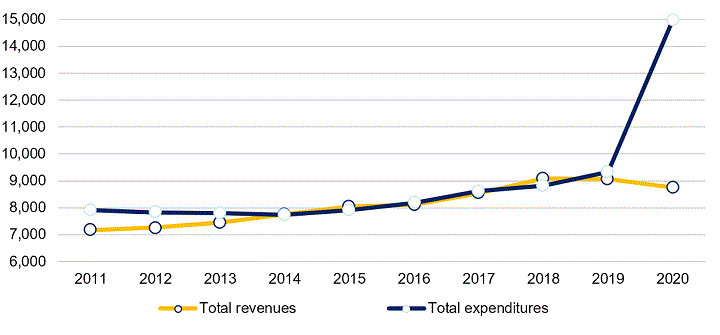
Sources: Figure prepared by the Library of Parliament using data obtained from Statistics Canada,
“Table 36-10-0450-01: Revenue, expenditure and budgetary balance – General governments, provincial and territorial economic accounts (× 1,000,000),” Database, accessed 31 October 2022;
and Statistics Canada, “Table 17-10-0005-01: Population estimates on July 1st, by age and sex,” Database, accessed 31 October 2022.
If the federal government spends more revenues than it receives, then per capita expenditures are higher than per capita revenues, as was the case from 2011 to 2013, from 2016 to 2017 and again from 2019 to 2020. Conversely, if the federal government receives more revenues than it spends, then per capita revenues are higher than per capita expenditures, as was the case in 2014, 2015 and 2018.
Figure 2 provides an overview of per capita federal revenues and expenditures in each province in 2020. For the first time since 1965, federal per capita expenditures exceeded revenues in all the provinces.
Alberta was the biggest contributor to federal revenues in 2020 on a per capita basis, due to strong increases in oil prices that year. In addition, British Columbia, Ontario and Newfoundland and Labrador all made contributions to federal revenues on a per capita basis that were above the national average.
Federal per capita expenditures were highest in the Atlantic provinces, with Prince Edward Island accounting for the highest per capita expenditures. That province also recorded the lowest per capita federal revenues.
Figure 2 – Federal Revenues and Expenditures by Province, 2020 ($ per capita)
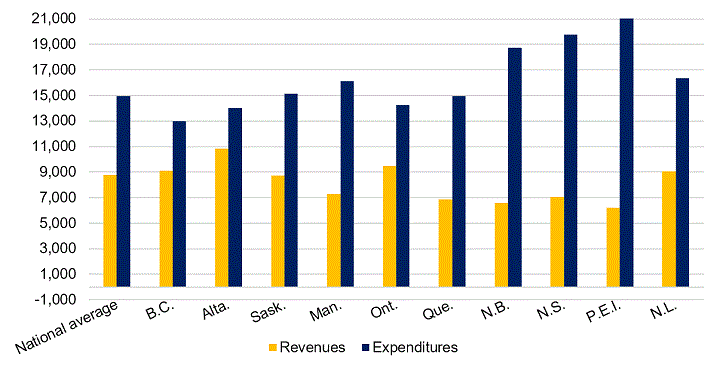
Sources: Figure prepared by the Library of Parliament using data obtained from Statistics Canada,
“Table 36-10-0450-01: Revenue, expenditure and budgetary balance – General governments, provincial and territorial economic accounts (× 1,000,000),” Database, accessed 31 October 2022; and Statistics Canada, “Table 17-10-0005-01: Population estimates on July 1st, by age and sex,” Database, accessed 31 October 2022.
The federal government has several revenue streams, including personal income tax, the goods and services tax, corporate income tax and employee contributions to social insurance plans (payroll taxes), such as employment insurance and the Canada Pension Plan.
Figure 3 shows federal revenues collected in 2020 by province and by source of revenue, as well as the percentage of population aged 65 and over for each province. Personal income tax is by far the largest source of revenue, accounting for nearly half of all federal revenues. In 2020, federal revenues per capita were higher than the national average in four provinces: British Columbia, Alberta, Ontario, and Newfoundland and Labrador. Because income tax rates are progressive, the federal government collects more personal income tax revenues in provinces that have higher income levels.2 Since federal tax rates do not vary by province, the federal government normally collects more revenues in provinces where economic and demographic conditions are more favourable. The same holds true for most of its revenue sources. Demographics is an important determinant of economic condition; a declining birth rate and an aging population often points to slower economic growth.
Figure 3 – Federal Revenues by Province and by Type ($ per capita) and Percentage of Population Aged 65 and Over, 2020
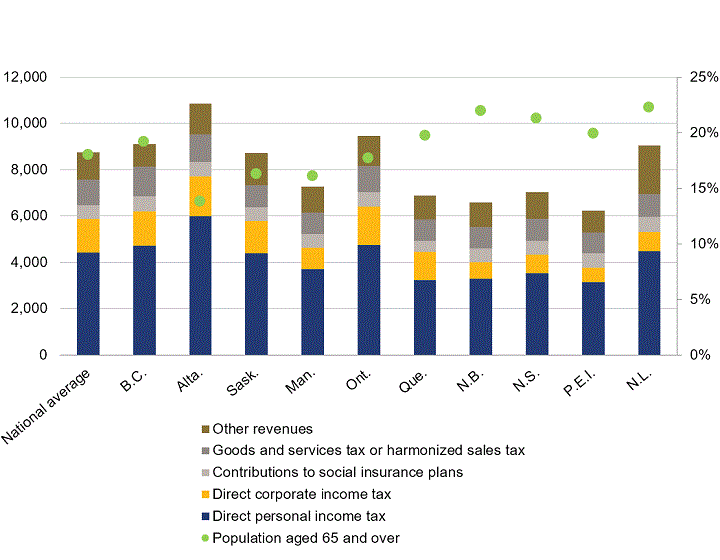
Sources: Figure prepared by the Library of Parliament using data obtained from Statistics Canada,
“Table 36-10-0450-01: Revenue, expenditure and budgetary balance – General governments, provincial and territorial economic accounts (× 1,000,000),” Database, accessed 31 October 2022; and Statistics Canada, “Table 17-10-0005-01: Population estimates on July 1st by age and sex,” Database, accessed 31 October 2022.
Federal government expenditures can be separated into three broad categories: program spending, debt servicing costs and other expenditures. Program spending, in turn, consists of three main types of expenditures: expenditures on goods and services, transfers to persons and transfers to the provinces. Figure 4 illustrates federal program spending per capita for each type of expenditure, except the cost of servicing the federal government’s debt.
Figure 4 – Federal Program Expenditures by Type, 2011–2020 ($ per capita)
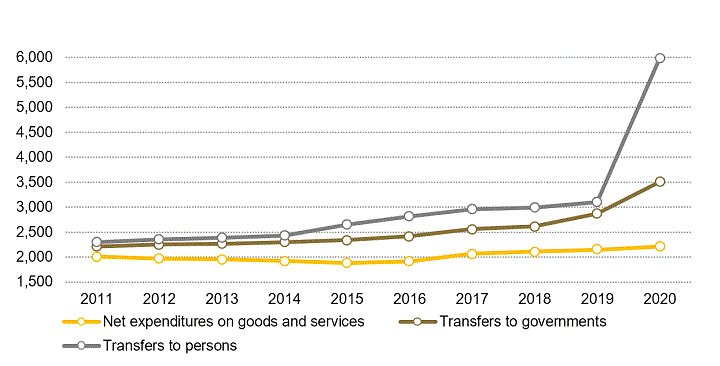
Source: Figure prepared by the Library of Parliament using data obtained from Statistics Canada,
“Table 36-10-0450-01: Revenue, expenditure and budgetary balance – General governments, provincial and territorial economic accounts (× 1,000,000),” Database, accessed 31 October 2022; and Statistics Canada, “Table 17-10-0005-01: Population estimates on July 1st, by age and sex,” Database, accessed 31 October 2022.
The first type of program expenditures covers basic government activities – the salaries of public sector employees, the day-to-day operations of government departments, and military installations and operations. It also includes the purchase of supplies and materials (see Figure 5).
Figure 5 – Federal Expenditures on Goods and Services by Province, 2020 ($ per capita)
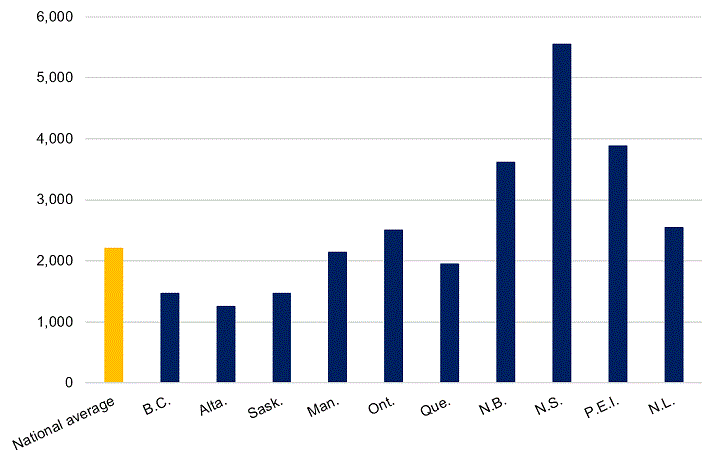
Sources: Figure prepared by the Library of Parliament using data obtained from Statistics Canada,
“Table 36-10-0450-01: Revenue, expenditure and budgetary balance – General governments, provincial and territorial economic accounts (× 1,000,000),” Database, accessed 31 October 2022; and Statistics Canada, “Table 17-10-0005-01: Population estimates on July 1st, by age and sex,” Database, accessed 31 October 2022.
On a per capita basis, federal government spending on goods and services is highest in the Atlantic provinces, particularly in Nova Scotia. Conversely, per capita federal spending on goods and services in British Columbia, Alberta, Saskatchewan and Quebec was markedly lower than in the rest of the country in 2020.
Per capita spending is a function of population and spending levels. Since the federal government strives to have an active presence throughout the country, lower population areas are likely to show higher per capita federal spending on goods and services. Certain locations have a natural propensity for federal government activity, for example, the National Capital Region. This may also be the case for Halifax since its large, natural, ice-free harbour is where the Atlantic naval base is located.
The second type of program expenditure, federal transfers to persons, comprises payments under federal programs such as Employment Insurance, the Canada Pension Plan and Old Age Security (see Figure 6).
The amounts paid are closely tied to the socio-economic conditions in the various provinces. As a result, provinces with relatively low income levels and relatively high unemployment rates tend to receive a larger per capita share of federal transfers to persons. A similar effect can be seen in provinces with larger populations of senior citizens or children.
Figure 6 – Federal Transfers to Persons by Province, 2020 ($ per capita)
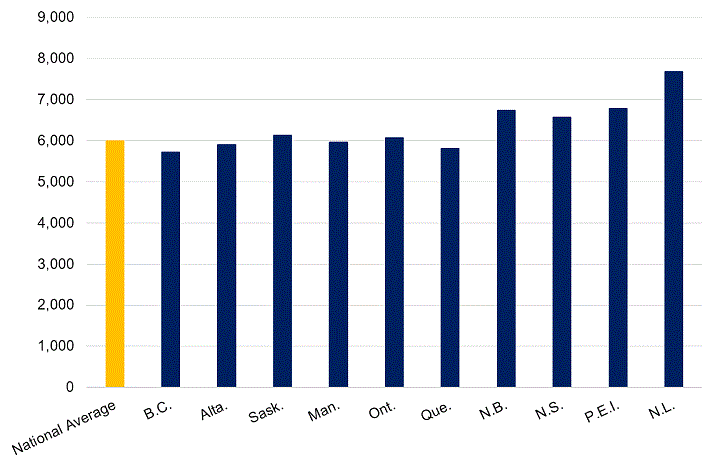
Sources: Figure prepared by the Library of Parliament using data obtained from Statistics Canada,
“Table 36-10-0450-01: Revenue, expenditure and budgetary balance – General governments, provincial and territorial economic accounts (× 1,000,000),” Database, accessed 31 October 2022; and Statistics Canada, “Table 17-10-0005-01: Population estimates on July 1st, by age and sex,” Database, accessed 31 October 2022.
For the most part, the eligibility criteria for a federal transfer do not vary based on provincial residency; they apply to individuals and families uniformly across Canada. The one exception is Employment Insurance, for which eligibility requirements take regional considerations into account. British Columbia, Manitoba and Quebec had transfers to persons that were below the national average of $5,995 in 2020; in contrast, Newfoundland and Labrador had the highest amount at $7,684 per capita.
The third type of program expenditure consists of transfers to provinces, including Equalization Program payments, the Canada Health Transfer and the Canada Social Transfer. The Equalization Program is designed to address fiscal disparities among provinces. It aims to provide less prosperous provinces the means to provide public services that are reasonably comparable to those in other provinces, at reasonably comparable levels of taxation.3 Payments to the provinces under the Canada Health Transfer and the Canada Social Transfer are made on an equal per capita cash basis.
Federal transfers to provinces vary from one province to the next (Figure 7), primarily because of the Equalization Program (in 2020, all provinces received such equalization payments).4 On a per capita basis, Prince Edward Island obtained the most in federal transfers in 2020, mainly because of the amount of equalization it received,5 whereas British Columbia, Alberta and Ontario obtained the least.
Figure 7 – Federal Transfers to Provinces, 2020 ($ per capita)
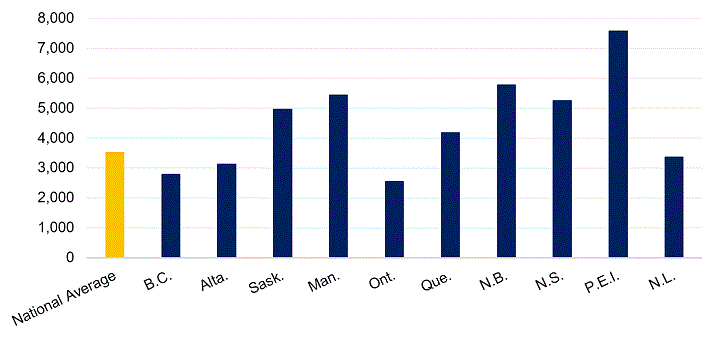
Sources: Figure prepared by the Library of Parliament using data obtained from Statistics Canada,
“Table 36-10-0450-01: Revenue, expenditure and budgetary balance – General governments, provincial and territorial economic accounts (× 1,000,000),” Database, accessed 31 October 2022; and Statistics Canada, “Table 17-10-0005-01: Population estimates on July 1st, by age and sex,” Database, accessed 31 October 2022.
Debt servicing costs (i.e., federal interest payments on the national debt) are the second major category of federal expenditure. The national debt and the interest payments on that debt are distributed equally across the country.6 Hence, the per capita cost of servicing the national public debt ($575 in 2020) is identical in each province. Debt servicing costs represented about 4% of total expenditures in 2020, down from 7% in 2019 given that government expenditures increased sharply during the COVID-19 pandemic.
The final category of expenditure, “Other,” accounts for less than 5% of total federal government expenditures. These expenditures include business subsidies, transfers to non-residents and certain payments to local governments.7
There is a clear redistributive effect to federal expenditures in Canada: the federal government receives more tax revenues in certain provinces and spends more in others. For the most part, differences in federal expenditures among provinces reflect federal programs and policies aimed at redistributing income from individuals with a higher income to individuals with a lower income, regardless of province of residence.
* This HillStudy is largely based on Sirina Kerim-Dikeni, Distribution of Federal Revenues and Expenditures by Province, Publication no. 2017-01-E, Library of Parliament, 6 October 2020.
© Library of Parliament